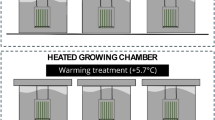Abstract
Eutrophication, which is the enrichment of a water mass with inorganic and organic nutrients that support plant growth, is a key factor in stimulating phytoplankton growth. In this study, we determined the effects of various nitrogen sources, different nitrogen concentrations in the culture medium, and two culture methods on the growth of the green alga, Enteromorpha prolifera. The relationship between the specific growth rate of E. prolifera and NO −3 -N concentration was consistent with that estimated using the Monod equation (R 2 = 0.9713, P < 0.01). In the NO −3 -N medium, the maximum specific growth rate was calculated to be 0.1634/d and the semi-saturation constant was calculated to be 16.86 μmol/L. Our results show that E. prolifera can effectively utilize NH +4 -N, NO −3 -N, and NO −2 -N and urea-N in the range of 5 to 50 μmol/L. NH +4 -N was preferentially assimilated by E. prolifera, and urea-N was favorable for long-term growth.
Similar content being viewed by others
References
Arzul G, Seguel M, Clement A. 2001. Effect of marine animal excretions on differential growth of phytoplankton species. Marine Science, 58: 386–390.
China Ocean News, 2007. <http://epaper.oceanol.com/zghyb/20070720/index.htm>.
China Ocean News, 2008b. <http://epaper.oceanol.com/zghyb/20080822/index.htm>.
China Ocean News, 2009. <http://epaper.oceanol.com/zghyb/20090724/index.htm>.
China Ocean News, 2010. <http://epaper.oceanol.com/zghyb/20100629/index.htm>.
Collos Y, Vaquer A, Bibent B et al. 2003. Response of coastal phytoplankton to ammonium and nitrate pulses: seasonal variations of nitrogen uptake and regeneration. Aquatic Ecology, 37: 227–236.
Fletcher R T, 1996. The occurrence of ‘green-tide’. In: Schramm W, Nienhuis P H eds. Marine Benthic Vegetation — Recent Changes and the Effects of Eutrophication. Springer Verlag, Berlin. p.7–43.
Fong P, Zedler J B, Donohoe R M. 1993. Nitrogen vs. phosphorus limitation of algal biomass in shallow coastal lagoons. Limnol. Oceanogr., 38(5): 906–923.
Franz D R, Friedman I. 2002. Effects of a macroalgal mat (Ulva lactuca) on estuarine sand flat copepods: an experimental study. J. Exp. Mar. Biol. Ecol., 271: 209–226.
Hallegraeff G M. 1993. A review of harmful algal blooms and their apparent global increase. Phycologia, 32: 9–99.
Hernandez I, Peralta G, Perez-Llorens J L, Vergara J J. 1997. Biomass and dynamics of growth of Ulva species in Palmones River estuary. J. Phycol., 33: 764–772.
Hu X, Wang W, Lin J M. 2000. Effect of light, nitrate and ammonium on the activity of nitrate reductase from Biddulphia regia. Journal of Xiamen University: Natural Science, 39(4): 516–520. (in Chinese with English abstract)
Jiang H M, Gao K S. 2004. Effects of nitrogen sources and concentrations on the growth and fatty acid composition of Phaeoda-ctylum Tricornutum. Acta Hydrobiologica Sinica, 28(5): 545–551. (in Chinese with English abstract)
Kester D R, Duedall I W, Connors D N, Pytkowicz R M. 1967. Preparation of Artificial Seawater. Limnology & Oceanography, 12: 176–179.
McGlathery K J. 2001. Macroalgal blooms contribute to the decline of seagrass in nutrient-enriched coastal waters. J. Phycol., 37: 453–456.
Ménesguen A, Piriou J Y. 1995. Nitrogen loadings and macroalgal (Ulva sp.) mass accumulation in Brittany (France). Ophelia, 42: 227–237.
Monod J. 1942. Recherche sur la croissance des cultures bactériennes. Paris: Harmann et Cie, 210.
Morand P, Briand X. 1996. Excessive growth of macroalgae: a symptom of environmental disturbance. Bot. Mar., 39: 491–516.
Morand P, Merceron M. 2004. Coastal Eutrophication and Excessive Growth of Macroalgae. In: Pandalai S G ed. Recent Research Developments in Environmental Biology. 1st edn. Research Signpost, Trivandrum, Kerala, India. p.395–449.
Nelson TA, Lee A. 2001. A manipulative experiment demonstrates that blooms of the macroalga Ulvaria obscura can reduce eelgrass shoot density. Aquat. Bot., 71:149–154.
Pedersen M F. 1995. Nitrogen limitation of photosynthesis and growth: comparison across aquatic plant communities in a Danish estuary (Roskilde Fjord). Ophelia, 41: 261–272.
Provasoli L. 1963. Organic regulation of phytoplankton fertility. In: Hill M N ed. In the Sea. Wiley-Interscience, New York. p.165–219.
Schramm W, Nienhuis P H. 1996. Introduction. In: Schramm W, Nienhuis P H eds. Marine Benthic Vegetation: Recent Changes and the Effects of Eutrophication. Springer-Verlag, Berlin, Heidelberg. p.1–4.
Sfriso A, Pavoni B, Marcomini A, Orio A A. 1988. Annual variations of nutrients in the lagoon of Venice. Mar. Pollut Bull., 19: 54–60.
Xu C L, Xu W L, Zhang C M. 1998. The Specification for Marine Monitoring. Standard Press of China, Beijing, China. p.165. (in Chinese)
Yasumoto T. 1990. Marine microorganisms toxins — an overview. In: Graneli E, Sundstrom B, Edler L, Anderson D M ed. Toxic Marine Phytoplankton. Elsevier, New York. p.3–8.
Valiela I, Clelland M J, Hauxwell J, Beh P J Hersh, D, Foreman K. 1997. Macroalgal blooms in shallow estuaries: controls and ecophysiological and ecosystem consequences. Limnol. Oceanogr., 42: 1 105–1 118.
Wang H, Wang H W. 2009. Investigation and Study on Enteromorpha in Liaoning Province. Journal of Anhui Agri. Sci., 37(6): 2 676–2 678. (in Chinese with English abstract)
Author information
Authors and Affiliations
Corresponding author
Additional information
Supported by the Major Projects of Knowledge Innovation Program of Chinese Academy of Sciences (No. KZCX2-SW-208-01); the National Natural Science Foundation of China (No. 40976047), and National Basic Research Program of China (973 Program) (No. 2010CB428701)
Rights and permissions
About this article
Cite this article
Li, J., Zhao, W. Effects of nitrogen specification and culture method on growth of Enteromorpha prolifera . Chin. J. Ocean. Limnol. 29, 874–882 (2011). https://doi.org/10.1007/s00343-011-0516-6
Received:
Accepted:
Published:
Issue Date:
DOI: https://doi.org/10.1007/s00343-011-0516-6




